Phone 093047 77993 | ||
 | ||
Hours Open today · 8AM–4:30PMThursday8AM–4:30PMFriday8AM–4:30PMSaturday8AM–4:30PMSunday8AM–4:30PMMonday8AM–4:30PMTuesday8AM–4:30PMWednesday8AM–4:30PM Similar Vishnupad Mandir, Chaitya, Bedse Caves, Bhaja Caves, Udayagiri - Odisha | ||
The Barabar Caves are the oldest surviving rock-cut caves in India, mostly dating from the Maurya Empire (322–185 BCE), some with Ashokan inscriptions, located in Makhdumpur Block of Jehanabad district, Bihar, India, 24 km north of Gaya.
Contents
These caves are situated in the twin hills of Barabar (four caves) and Nagarjuni (three caves) – caves of the 1.6 km distant Nagarjuni Hill sometimes are singled out as Nagarjuni Caves. These rock-cut chambers date back to the 3rd century BCE, Maurya period, of Ashoka (r. 273–232 BCE) and his grandson Dasharatha Maurya. Though Buddhists themselves, they allowed various Jain sects to flourish under a policy of religious tolerance.
The caves were used by ascetics from the Ajivika sect, founded by Makkhali Gosala, a contemporary of Gautama Buddha, the founder of Buddhism, and of Mahavira, the last and 24th Tirthankara of Jainism. Also present at the site are several rock-cut Buddhist and Hindu sculptures.
Most caves at Barabar consist of two chambers, carved entirely out of granite, with a highly polished internal surface and exciting echo effect. The first chamber was meant for worshippers to congregate in a large rectangular hall, and the second, a small, circular, domed chamber for worship, this inner chamber probably had a small stupa like structure, at some point, though they are now empty.
The caves were featured – located in a fictitious Marabar – in the book A Passage to India by English author E. M. Forster. These were also shown in the book The Mahabharata Secret by Indian author Christopher C. Doyle.
Mysterious barabar caves india
Caves at Barabar Hill
Barabar Hill contains four caves, namely, Karan Chaupar, Lomas Rishi, Sudama and Visva Zopri. Sudama and Lomas Rishi Caves are the earliest examples of rock-cut architecture in India, with architectural detailing, made in the Mauryan period, and became a trend the subsequent centuries, like the larger Buddhist Chaitya, that were found in Maharashtra, such as in Ajanta and Karla Caves, and greatly influenced the tradition of South Asian rock-cut architecture. Barabar caves have magnanimous arches which are few in ancient history.
Nagarjuni Caves
Nearby caves of Nagarjuna are smaller and younger than Barabar caves The three caves are:
